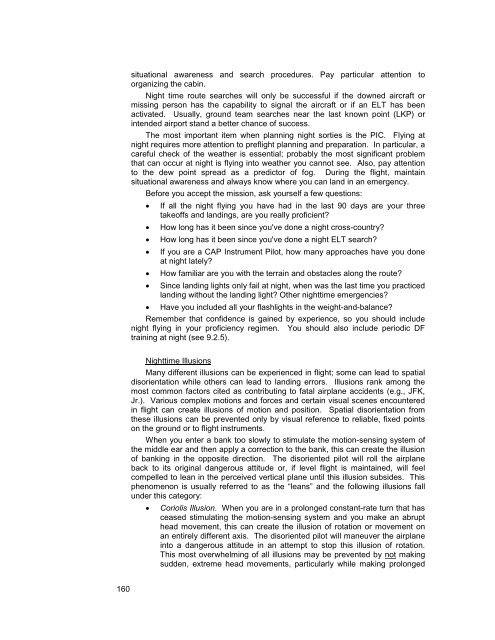MART Vol. II MO/MP - NESA - Civil Air Patrol
MART Vol. II MO/MP - NESA - Civil Air Patrol
MART Vol. II MO/MP - NESA - Civil Air Patrol
You also want an ePaper? Increase the reach of your titles
YUMPU automatically turns print PDFs into web optimized ePapers that Google loves.
situational awareness and search procedures. Pay particular attention toorganizing the cabin.Night time route searches will only be successful if the downed aircraft ormissing person has the capability to signal the aircraft or if an ELT has beenactivated. Usually, ground team searches near the last known point (LKP) orintended airport stand a better chance of success.The most important item when planning night sorties is the PIC. Flying atnight requires more attention to preflight planning and preparation. In particular, acareful check of the weather is essential; probably the most significant problemthat can occur at night is flying into weather you cannot see. Also, pay attentionto the dew point spread as a predictor of fog. During the flight, maintainsituational awareness and always know where you can land in an emergency.Before you accept the mission, ask yourself a few questions:• If all the night flying you have had in the last 90 days are your threetakeoffs and landings, are you really proficient?• How long has it been since you've done a night cross-country?• How long has it been since you've done a night ELT search?• If you are a CAP Instrument Pilot, how many approaches have you doneat night lately?• How familiar are you with the terrain and obstacles along the route?• Since landing lights only fail at night, when was the last time you practicedlanding without the landing light? Other nighttime emergencies?• Have you included all your flashlights in the weight-and-balance?Remember that confidence is gained by experience, so you should includenight flying in your proficiency regimen. You should also include periodic DFtraining at night (see 9.2.5).Nighttime IllusionsMany different illusions can be experienced in flight; some can lead to spatialdisorientation while others can lead to landing errors. Illusions rank among themost common factors cited as contributing to fatal airplane accidents (e.g., JFK,Jr.). Various complex motions and forces and certain visual scenes encounteredin flight can create illusions of motion and position. Spatial disorientation fromthese illusions can be prevented only by visual reference to reliable, fixed pointson the ground or to flight instruments.When you enter a bank too slowly to stimulate the motion-sensing system ofthe middle ear and then apply a correction to the bank, this can create the illusionof banking in the opposite direction. The disoriented pilot will roll the airplaneback to its original dangerous attitude or, if level flight is maintained, will feelcompelled to lean in the perceived vertical plane until this illusion subsides. Thisphenomenon is usually referred to as the “leans” and the following illusions fallunder this category:• Coriolis Illusion. When you are in a prolonged constant-rate turn that hasceased stimulating the motion-sensing system and you make an abrupthead movement, this can create the illusion of rotation or movement onan entirely different axis. The disoriented pilot will maneuver the airplaneinto a dangerous attitude in an attempt to stop this illusion of rotation.This most overwhelming of all illusions may be prevented by not makingsudden, extreme head movements, particularly while making prolonged160














